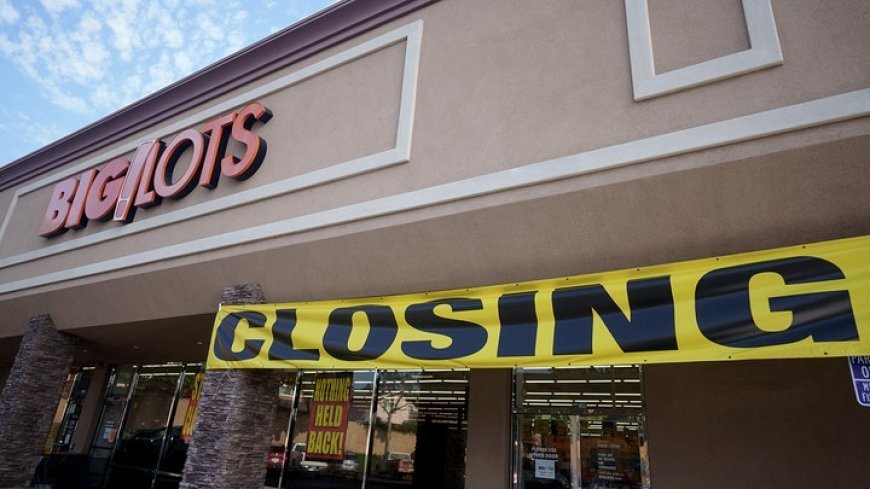Big Lots Files for Bankruptcy Amid Economic Turbulence | What It Means for the Retail Sector
In a surprising turn of events, Big Lots, one of the most well-known discount retail chains in the United States, has filed for bankruptcy. As the company faces mounting financial pressures, the decision to close several stores and secure a deal with an investment firm signals a challenging period ahead. This move is a reflection of broader shifts in the retail sector, particularly for businesses that rely on discount shoppers and physical storefronts. The filing comes at a time when economic uncertainties are prompting many companies to reassess their operational strategies.

In a surprising turn of events, Big Lots, one of the most well-known discount retail chains in the United States, has filed for bankruptcy. As the company faces mounting financial pressures, the decision to close several stores and secure a deal with an investment firm signals a challenging period ahead. This move is a reflection of broader shifts in the retail sector, particularly for businesses that rely on discount shoppers and physical storefronts. The filing comes at a time when economic uncertainties are prompting many companies to reassess their operational strategies.
In this article, we will dive deep into the factors behind Big Lots' bankruptcy, the implications for the retail industry, and what this means for consumers and investors.
The Fall of Big Lots: A Struggle to Stay Afloat
Big Lots has long been a fixture in the discount retail industry, offering a wide range of products from home goods to furniture at significantly reduced prices. Despite its efforts to maintain profitability, the company has struggled in recent years due to various challenges, including increased competition, changing consumer preferences, and the rise of e-commerce giants like Amazon and Walmart.
Over the last few years, Big Lots faced significant operational hurdles. Declining foot traffic in brick-and-mortar stores, combined with supply chain disruptions caused by the global pandemic, severely impacted the company's ability to maintain a competitive edge. Additionally, rising inflation rates put further strain on its business model, as many customers became more cost-conscious, cutting back on non-essential spending.
While Big Lots attempted to revamp its online presence and diversify its product offerings, these efforts fell short of expectations. Increased competition from discount retailers such as Dollar General and Five Below further compounded the issue, leaving Big Lots with fewer avenues for growth and recovery.
Key Reasons Behind the Bankruptcy Filing
The decision to file for bankruptcy was not made lightly. Several critical factors have contributed to this drastic step:
1. Declining Sales and Revenue
One of the primary reasons behind Big Lots' financial difficulties is the consistent decline in sales and revenue. As the company expanded, it became increasingly challenging to maintain profitability across its large network of stores. The shift in consumer behavior, with more shoppers opting for online shopping over in-store experiences, further exacerbated this issue. Despite efforts to strengthen its e-commerce platform, Big Lots found it difficult to compete with more established digital players.
2. Rising Operational Costs
Big Lots has also been hit hard by rising operational costs. The ongoing inflationary pressures have led to increased costs for labor, utilities, and rent, squeezing profit margins. Additionally, supply chain disruptions caused by both global and domestic challenges have resulted in increased expenses for transporting goods to stores. These factors, combined with shrinking revenue streams, made it nearly impossible for Big Lots to operate sustainably.
3. Debt Burden and Cash Flow Issues
Another contributing factor to Big Lots' bankruptcy is its growing debt burden. To stay competitive, the company took on significant amounts of debt to fund expansions, marketing campaigns, and improvements to its stores. Unfortunately, as sales continued to lag, Big Lots found itself struggling to manage these financial obligations. Cash flow issues became more pronounced, leaving the company unable to meet its debt obligations, pay vendors, and fund day-to-day operations.
4. Increased Competition in the Discount Retail Sector
Big Lots operates in a highly competitive space, where other discount retailers have thrived by adapting more quickly to market trends. Companies like Dollar Tree, Family Dollar, and TJ Maxx have found ways to stay ahead by streamlining their operations, expanding their product offerings, and embracing digital transformation. Big Lots, on the other hand, was slower to react to these changes, which ultimately hurt its ability to retain and attract customers.
Store Closures: A Strategic Move or Desperation?
In response to the financial turmoil, Big Lots has announced plans to close underperforming stores. This decision is part of a broader strategy to cut costs and streamline operations. The company believes that by focusing on its most profitable locations, it can return to profitability and emerge from bankruptcy stronger.
However, store closures often signal deeper issues within a retail business. For Big Lots, this move may be seen as a last-ditch effort to salvage what remains of the company. The closures will undoubtedly impact employees, local communities, and loyal customers, many of whom rely on Big Lots for affordable goods.
The Role of the Investment Firm: A Glimmer of Hope?
As part of its bankruptcy proceedings, Big Lots has struck a deal with an unnamed investment firm. This firm will provide the necessary funding to keep the company afloat while it navigates the restructuring process. The hope is that with new leadership and financial backing, Big Lots can chart a course for recovery and emerge as a leaner, more competitive entity in the retail landscape.
This infusion of capital provides a temporary lifeline, allowing Big Lots to continue operating while addressing its financial obligations. The investment firm will likely play a key role in shaping the future of Big Lots, including decisions around further store closures, operational improvements, and potential shifts in business strategy.
Implications for the Broader Retail Industry
Big Lots' bankruptcy is a stark reminder of the challenges facing traditional brick-and-mortar retailers in today’s economy. The rise of e-commerce, shifting consumer preferences, and macroeconomic pressures have created an environment where only the most adaptable companies can thrive.
Other retailers may view Big Lots' downfall as a cautionary tale. Companies that fail to invest in digital transformation, operational efficiency, and customer engagement are at risk of facing similar fates. As the retail sector continues to evolve, those who prioritize innovation, flexibility, and strategic foresight will be best positioned to succeed.
What Does This Mean for Consumers?
For consumers, the closure of Big Lots stores may lead to a reduction in choices, especially for those who rely on discount retailers for affordable household goods. With fewer locations available, customers may be forced to turn to alternative retailers or embrace online shopping options for similar products.
However, the bankruptcy proceedings may also present opportunities for savvy shoppers. As Big Lots looks to liquidate its inventory, consumers may find steep discounts on remaining products in closing stores. For bargain hunters, this could be a silver lining amidst the turmoil.
Looking Ahead: Can Big Lots Bounce Back?
While Big Lots' future is uncertain, the company is not without hope. Bankruptcy can provide a fresh start for businesses that successfully restructure their operations and finances. By focusing on its core strengths, such as its strong brand recognition and loyal customer base, Big Lots could emerge from this period of turbulence in a more sustainable position.
The support from the investment firm also bodes well for the company’s recovery. With the right leadership and a clear strategic direction, Big Lots could potentially regain its footing in the retail market.
What's Your Reaction?


























